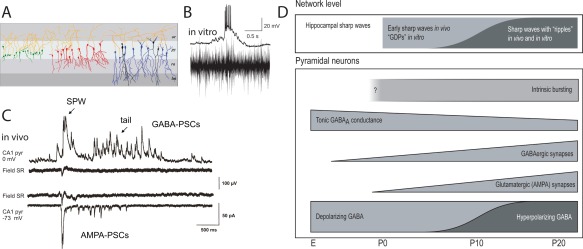Figure 29.

SPW‐Rs in early development. (A) Three different type of CA1 pyramidal cells are encountered at birth: cells that are synaptically silent, cells with only GABAergic synaptic activity and cells with both GABAergic and glutamatergic synaptic activity. (B) Simultaneous recordings of a CA3 pyramidal cell and extracellular multiple unit burst in CA3 pyramidal cell layer in postnatal day 6 hippocampal slice during GDP. (C) Intracellular correlates of SPWs (GDP) in vivo. Intracellular (CA1 pyramidal cell, whole‐cell) and extracellular (stratum radiatum, SR) recordings during a SPW event in a postnatal day 5 pup. Upper pair: intracellular voltage clamp at glutamate reversal potential (0 mV), showing presumed GABAA receptor‐mediated postsynaptic currents (upward deflections). Lower pair: intracellular voltage clamp at GABAA reversal potential (−73 mV), showing presumed glutamate receptor‐mediated postsynaptic currents (downward deflections). (D) Developmental changes of hippocampal network events and single neuron properties. Already at the embryonic stage, immature pyramidal neurons have a large tonic GABAergic conductance. GABAergic synapses are functional before glutamatergic ones, but GDPs/SPWs are first seen only after the establishment of functional glutamatergic synapses. CA3 pyramidal neurons generate intrinsic burst activity throughout postnatal development. In vitro, the probability of GDP occurrence decreases as the GABAA‐receptor mediate action shifts from depolarizing to hyperpolarizing. In vivo, SPWs are the first endogenous event of activity seen during ontogeny but ripple oscillation emerge at an older age. The approximate developmental time scale shows the late embryonic period (E) and the postnatal period from P0 (postnatal day 0; time of birth) to P20 in rats. A and B, reproduced from Ben‐Ari (2001), C, reproduced from Leinegukel et al. (2002), D, reproduced from Sipilä and Kaila (2007).
